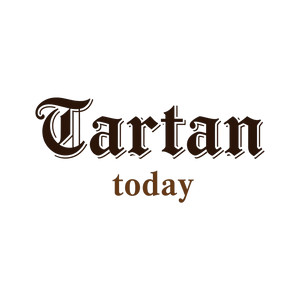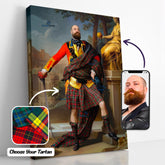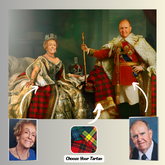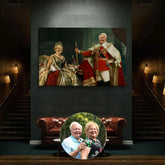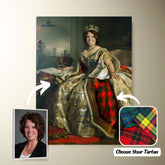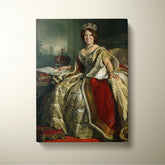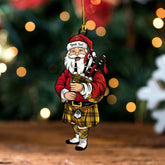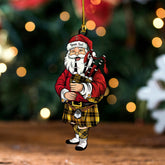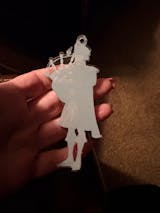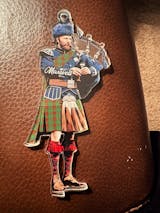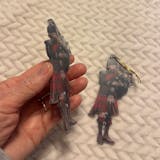-
Personalized Clan Barclay Hunting Ancient Tartan Bagpipe Ornament with Custom Name – Scottish Christmas Tree Decoration MC72
Personalized Clan Barclay Hunting Ancient Tartan Bagpipe Ornament with Custom Name – Scottish Christmas Tree Decoration MC72Celebrate your Scottish heritage with this unique wood & acrylic tartan ornament. Perfect as a personalized Christmas decoration or a meaningful gift for friends and relatives on special...- From $19.99 USD
$25.99 USD- From $19.99 USD
- Unit price
- per
Save $6.00 -
Personalized Clan Barclay Dress Modern Tartan Bagpipe Ornament with Custom Name – Scottish Christmas Tree Decoration FN25
Personalized Clan Barclay Dress Modern Tartan Bagpipe Ornament with Custom Name – Scottish Christmas Tree Decoration FN25Celebrate your Scottish heritage with this unique wood & acrylic tartan ornament. Perfect as a personalized Christmas decoration or a meaningful gift for friends and relatives on special...- From $19.99 USD
$25.99 USD- From $19.99 USD
- Unit price
- per
Save $6.00 -
Clan Barclay Dress Modern Tartan Flat Cap GO94 - Clan Barclay Dress Modern Tartan
Clan Barclay Dress Modern Tartan Flat Cap GO94Elevate Your Heritage: The Authentic Tartan Jeff Cap Step into a legacy of timeless style and comfort with our Authentic Tartan Flat Cap. Crafted for the discerning American who cherishes their Scottish roots and appreciates classic elegance, this...- From $33.85 USD
$45.59 USD- From $33.85 USD
- Unit price
- per
Save $11.74-
Clan Barclay Dress Modern Tartan
-
Clan Barclay Hunting Ancient Tartan Scottish Lion Hawaiian Shirt TN97 - Barclay Hunting Ancient Tartan
Barclay Hunting Ancient Tartan Clan Scottish Lion Hawaiian Shirt TN97 These Hawaiian shirts and shorts are suitable for hot summer days or beach trips with your friends, family, and loved ones. This is an excellent gift, vacation outfit, or simply revamp your summer wardrobe.-...- $43.25 USD
- $43.25 USD
- Unit price
- per
-
Barclay Hunting Ancient Tartan
-
Personalized Clan Barclay Hunting Ancient Tartan Drummer Ornament with Custom Name – Scottish Christmas Tree Decoration DN22
Personalized Clan Barclay Hunting Ancient Tartan Drummer Ornament with Custom Name – Scottish Christmas Tree Decoration DN22Celebrate your Scottish heritage with this unique wood & acrylic tartan ornament. Perfect as a personalized Christmas decoration or a meaningful gift for friends and relatives on special...- From $19.99 USD
$25.99 USD- From $19.99 USD
- Unit price
- per
Save $6.00 -
Personalized Clan Barclay Dress Modern Tartan Drummer Ornament with Custom Name – Scottish Christmas Tree Decoration UB72
Personalized Clan Barclay Dress Modern Tartan Drummer Ornament with Custom Name – Scottish Christmas Tree Decoration UB72Celebrate your Scottish heritage with this unique wood & acrylic tartan ornament. Perfect as a personalized Christmas decoration or a meaningful gift for friends and relatives on special...- From $19.99 USD
$25.99 USD- From $19.99 USD
- Unit price
- per
Save $6.00 -
Personalized Clan Barclay Hunting Reproduction Tartan Bagpipe Ornament with Custom Name – Scottish Christmas Tree Decoration HK60
Personalized Clan Barclay Hunting Reproduction Tartan Bagpipe Ornament with Custom Name – Scottish Christmas Tree Decoration HK60Celebrate your Scottish heritage with this unique wood & acrylic tartan ornament. Perfect as a personalized Christmas decoration or a meaningful gift for friends and relatives on special...- From $19.99 USD
$25.99 USD- From $19.99 USD
- Unit price
- per
Save $6.00 -
Personalized Clan Barclay Hunting Modern Tartan Bagpipe Ornament with Custom Name – Scottish Christmas Tree Decoration TY12
Personalized Clan Barclay Hunting Modern Tartan Bagpipe Ornament with Custom Name – Scottish Christmas Tree Decoration TY12Celebrate your Scottish heritage with this unique wood & acrylic tartan ornament. Perfect as a personalized Christmas decoration or a meaningful gift for friends and relatives on special...- From $19.99 USD
$25.99 USD- From $19.99 USD
- Unit price
- per
Save $6.00 -
Personalized Clan Barclay Dress Reproduction Tartan Bagpipe Ornament with Custom Name – Scottish Christmas Tree Decoration SV55
Personalized Clan Barclay Dress Reproduction Tartan Bagpipe Ornament with Custom Name – Scottish Christmas Tree Decoration SV55Celebrate your Scottish heritage with this unique wood & acrylic tartan ornament. Perfect as a personalized Christmas decoration or a meaningful gift for friends and relatives on special...- From $19.99 USD
$25.99 USD- From $19.99 USD
- Unit price
- per
Save $6.00 -
Personalized Clan Barclay Dress Muted Tartan Bagpipe Ornament with Custom Name – Scottish Christmas Tree Decoration TJ24
Personalized Clan Barclay Dress Muted Tartan Bagpipe Ornament with Custom Name – Scottish Christmas Tree Decoration TJ24Celebrate your Scottish heritage with this unique wood & acrylic tartan ornament. Perfect as a personalized Christmas decoration or a meaningful gift for friends and relatives on special...- From $19.99 USD
$25.99 USD- From $19.99 USD
- Unit price
- per
Save $6.00 -
Personalized Clan Barclay Dress Ancient Tartan Bagpipe Ornament with Custom Name – Scottish Christmas Tree Decoration HM48
Personalized Clan Barclay Dress Ancient Tartan Bagpipe Ornament with Custom Name – Scottish Christmas Tree Decoration HM48Celebrate your Scottish heritage with this unique wood & acrylic tartan ornament. Perfect as a personalized Christmas decoration or a meaningful gift for friends and relatives on special...- From $19.99 USD
$25.99 USD- From $19.99 USD
- Unit price
- per
Save $6.00 -
Personalized Clan Barclay Dress Weathered Clan Crest Tartan Santa Ornament – Custom Acrylic Christmas Decoration PO76 - Barclay
Personalized Clan Barclay Dress Weathered Clan Badge Tartan Ornament – Custom Acrylic Christmas Decoration PO76Celebrate your Scottish heritage with this unique wood & acrylic tartan ornament. Perfect as a personalized Christmas decoration or a meaningful gift for friends and relatives on special occasions such...- From $19.99 USD
- From $19.99 USD
- Unit price
- per
-
Barclay
-
Personalized Clan Barclay Dress Ancient Clan Crest Tartan Santa Ornament – Custom Acrylic Christmas Decoration AB72 - Barclay
Personalized Clan Barclay Dress Ancient Clan Badge Tartan Ornament – Custom Acrylic Christmas Decoration AB72Celebrate your Scottish heritage with this unique wood & acrylic tartan ornament. Perfect as a personalized Christmas decoration or a meaningful gift for friends and relatives on special occasions such...- From $19.99 USD
- From $19.99 USD
- Unit price
- per
-
Barclay
-
Personalized Clan Barclay Dress Modern Clan Crest Tartan Santa Ornament – Custom Acrylic Christmas Decoration BO15 - Barclay
Personalized Clan Barclay Dress Modern Clan Badge Tartan Ornament – Custom Acrylic Christmas Decoration BO15Celebrate your Scottish heritage with this unique wood & acrylic tartan ornament. Perfect as a personalized Christmas decoration or a meaningful gift for friends and relatives on special occasions such...- From $19.99 USD
- From $19.99 USD
- Unit price
- per
-
Barclay
-
Personalized Clan Barclay Dress Modern Clan Crest Tartan Santa Ornament – Custom Acrylic Christmas Decoration TX47 - Barclay
Personalized Clan Barclay Dress Modern Clan Badge Tartan Ornament – Custom Acrylic Christmas Decoration TX47Celebrate your Scottish heritage with this unique wood & acrylic tartan ornament. Perfect as a personalized Christmas decoration or a meaningful gift for friends and relatives on special occasions such...- From $19.99 USD
- From $19.99 USD
- Unit price
- per
-
Barclay
-
Personalized Clan Barclay Dress Modern Clan Crest Tartan Santa Ornament – Custom Acrylic Christmas Decoration PI94 - Barclay
Personalized Clan Barclay Dress Modern Clan Badge Tartan Ornament – Custom Acrylic Christmas Decoration PI94Celebrate your Scottish heritage with this unique wood & acrylic tartan ornament. Perfect as a personalized Christmas decoration or a meaningful gift for friends and relatives on special occasions such...- From $19.99 USD
- From $19.99 USD
- Unit price
- per
-
Barclay
-
Personalized Clan Barclay Hunting 2 Ancient Tartan Santa Ornament – Custom Acrylic Christmas Decoration XB90 - Barclay
Personalized Clan Barclay Hunting 2 Ancient Tartan Ornament – Custom Acrylic Christmas Decoration XB90Celebrate your Scottish heritage with this unique wood & acrylic tartan ornament. Perfect as a personalized Christmas decoration or a meaningful gift for friends and relatives on special occasions such as...- From $19.99 USD
- From $19.99 USD
- Unit price
- per
-
Barclay
-
Personalized Clan Barclay Hunting Modern Tartan Santa Ornament – Custom Acrylic Christmas Decoration SQ88 - Barclay
Personalized Clan Barclay Hunting Modern Tartan Ornament – Custom Acrylic Christmas Decoration SQ88Celebrate your Scottish heritage with this unique wood & acrylic tartan ornament. Perfect as a personalized Christmas decoration or a meaningful gift for friends and relatives on special occasions such as Christmas,...- From $19.99 USD
- From $19.99 USD
- Unit price
- per
-
Barclay
-
Personalized Clan Barclay Hunting Ancient Tartan Santa Ornament – Custom Acrylic Christmas Decoration QT38 - Barclay
Personalized Clan Barclay Hunting Ancient Tartan Ornament – Custom Acrylic Christmas Decoration QT38Celebrate your Scottish heritage with this unique wood & acrylic tartan ornament. Perfect as a personalized Christmas decoration or a meaningful gift for friends and relatives on special occasions such as Christmas,...- From $19.99 USD
- From $19.99 USD
- Unit price
- per
-
Barclay
-
Personalized Clan Barclay Hunting Weathered Tartan Santa Ornament – Custom Acrylic Christmas Decoration CU17 - Barclay
Personalized Clan Barclay Hunting Weathered Tartan Ornament – Custom Acrylic Christmas Decoration CU17Celebrate your Scottish heritage with this unique wood & acrylic tartan ornament. Perfect as a personalized Christmas decoration or a meaningful gift for friends and relatives on special occasions such as Christmas,...- From $19.99 USD
- From $19.99 USD
- Unit price
- per
-
Barclay
Ex: Your Tartan + Product
Popular Products
Turn Me Royal Personalized Portrait from Your Photo, Custom Tartan. Custom Canvas Wall Art as Gift for Men
- From $32.45 USD
- From $32.45 USD
- Unit price
- / per
Royalty Couple Personalized Portrait from Your Photo, Custom Tartan. Custom Canvas Wall Art
- From $47.45 USD
- From $47.45 USD
- Unit price
- / per
The Queen Personalized Portrait from Your Photo, Custom Tartan. Custom Canvas Wall Art as Gift for Women
- From $32.45 USD
- From $32.45 USD
- Unit price
- / per
Which Clan Are You From?
- Apron
- Barclay
- Barclay clanBarclay tartanPillow Cover
- Barclay Dress
- Barclay Dress Ancient
- Barclay Dress Modern
- Barclay Dress Modern Gnome
- Barclay Dress Modern Tartan
- Barclay Dress Muted
- Barclay Dress Reproduction
- Barclay Dress Weathered
- Barclay Hunting 2 Ancient
- Barclay Hunting Ancient
- Barclay Hunting Ancient Gnome
- Barclay Hunting Ancient Tartan
- Barclay Hunting Modern
- Barclay Hunting Reproduction
- Barclay Hunting Weathered
- Barclay Tartan
- Barclay Tartan Clan
- Scott
List Of Tartan
-
Clan A
- Abercrombie Tartan
- Aberdeen Tartan
- Abernethy Tartan
- Adair Tartan
- Adam Tartan
- Ayrshire Tartan
- Agnew Tartan
- Aikenhead Tartan
- Ainslie Tartan
- Aiton Tartan
- Allan Tartan
- Alexander Tartan
- Allardice Tartan
- Allison Tartan
- Anderson Tartan
- Angus Tartan
- Anstruther Tartan
- Arbuthnot Tartan
- Armstrong Tartan
- Arnott Tartan
- Auchinleck Tartan
- Ayrshire Tartan
-
Clan B
- Baillie Tartan
- Bain Tartan
- Baird Tartan
- Balfour Tartan
- Bannatyne Tartan
- Bannerman Tartan
- Barclay Tartan
- Baxter Tartan
- Beaton Tartan
- Bell Tartan
- Belshes Tartan
- Bethune Tartan
- Beveridge Tartan
- Binning Tartan
- Bisset Tartan
- Blackadder Tartan
- Blackstock Tartan
- Black Watch Tartan
- Blair Tartan
- Blane Tartan
- Blyth Tartan
- Borthwick Tartan
- Boswell Tartan
- Bowie Tartan
- Boyd Tartan
- Boyle Tartan
- Brisbane Tartan
- Brodie Tartan
- Brown/ Broun Tartan
- Bruce Tartan
- Buccleuch Tartan
- Buchan Tartan
- Buchanan Tartan
- Burnett Tartan
- Burns Tartan
- Butter Tartan
- Byres Tartan
-
Clan C
- Cairns Tartan
- Calder Tartan
- Callander Tartan
- Cameron Tartan
- Campbell Tartan
- Campbell of Breadalbane Tartan
- Campbell of Cawdor Tartan
- Carmichael Tartan
- Carnegie Tartan
- Carruthers Tartan
- Cathcart Tartan
- Chalmers Tartan
- Charteris Tartan
- Chattan Tartan
- Cheyne Tartan
- Chisholm Tartan
- Christie Tartan
- Clark Tartan
- Clelland Tartan
- Clephan Tartan
- Clergy Tartan
- Cochrane Tartan
- Cockburn Tartan
- Colquhoun Tartan
- Colville Tartan
- Cooper Tartan
- Couper Tartan
- Craig Tartan
- Cranstoun Tartan
- Crawford Tartan
- Crichton Tartan
- Crief District Tartan
- Crosbie Tartan
- Cumming Tartan
- Cunningham Tartan
- Currie Tartan
- Clan D
- Clan E
- Clan F
- Clan G
- Clan H
- Clan I
- Clan J
- Clan K
- Clan L
-
Clan M
- Maitland Tartan
- Malcolm Tartan
- Mar Tartan
- Marjoribanks Tartan
- Maxtone Tartan
- Matheson Tartan
- Maule Tartan
- Maxwell Tartan
- Meldrum Tartan
- Melville Tartan
- Menzies Tartan
- Mercer Tartan
- Middleton Tartan
- Moffat Tartan
- Moncrieffe Tartan
- Montgomery Tartan
- Monypenny Tartan
- Moncreiffe Tartan
- Monteith Tartan
- Morrison Tartan
- Mouat Tartan
- Moubray Tartan
- Mow Tartan
- Muir_More Tartan
- Muirhead Tartan
- Munro Tartan
- Murray Tartan
- Murray of Atholl Tartan
-
Clan Mc/Mac
- MacAlister Tartan
- MacArthur Tartan
- MacAlpine Tartan
- MacAulay Tartan
- MacBain Tartan
- MacBean Tartan
- MacBeth Tartan
- MacCallum Tartan
- MacCraig Tartan
- MacColl Tartan
- MacCorquodale Tartan
- MacDiarmid Tartan
- MacDonald Tartan
- MacDonald of Clanranald Tartan
- MacDonald of Sleat Tartan
- MacDonnell of Glengarry Tartan
- MacDonnell of Keppoch Tartan
- MacDougall Tartan
- MacDowall Tartan
- MacDuff Tartan
- MacEwen_MacEwan Tartan
- MacEdward Tartan
- MacFarlane Tartan
- MacGill Tartan
- MacGillivray Tartan
- MacGregor Tartan
- MacGowan (McGowan) Tartan
- MacHardy Tartan
- MacIan Tartan
- MacInnes Tartan
- MacIntyre Tartan
- MacKay Tartan
- MacKillop Tartan
- MacKellar Tartan
- Mackinlay Tartan
- MacKenzie Tartan
- Mackie Tartan
- MacKinnon Tartan
- MacKintosh / MacIntosh Tartan
- MacLeod Tartan
- MacMillan Tartan
- MacNab Tartan
- MacNaughton Tartan
- MacNeil / MacNeill Tartan
- MacNeil of Colonsay Tartan
- MacNicol Tartan
- MacPhail Tartan
- MacPhee_MacFie Tartan
- MacPherson Tartan
- MacQuarrie Tartan
- MacQueen Tartan
- MacRae Tartan
- MacRow Tartan
- MacSporran Tartan
- MacTaggart Tartan
- MacTavish Tartan
- MacThomas Tartan
- McCorquodale Tartan
- McCulloch Tartan
- McFadzen Tartan
- McGeachie Tartan
- McIver Tartan
- McKerrell Tartan
- Clan N
- Clan O
- Clan P
- Clan R
-
Clan S
- Sandilands Tartan
- Scott Tartan
- Scrymgeour Tartan
- Selkirk Tartan
- Sempill Tartan
- Seton Tartan
- Shaw Tartan
- Shepherd Tartan
- Sinclair Tartan
- Skene Tartan
- Skirving Tartan
- Smith Tartan
- Somerville Tartan
- Spalding Tartan
- Spens Tartan
- Spottiswood Tartan
- Stevenson Tartan
- Stewart Tartan
- Stewart of Appin Tartan
- Stirling Tartan
- Strachan Tartan
- Straiton Tartan
- Strange Tartan
- Strathclyde District Tartan
- Stuart of Bute Tartan
- Sutherland Tartan
- Swinton Tartan
- Clan T
- Clan U W Y
- Request Your Clan
Clan Barclay (Barclay Tartan)
1. About Clan Barclay (Barclay Tartan)
2. Clan Barclay History (Barclay Tartan)
During the Norman Conquest, the Barclays migrated from France to Gloucestershire. Their name was originally spelled "de Berchelai," which may have been an Anglo-Saxon combination of the words "beautiful" (beautiful) and "lee" (meadow or field).
The early Gloucester settlers also tended to have the first names Roger and Ralph more frequently than other names.
Castle in Towie Barclay in Aberdeenshire. Despite having owned the grounds there since the 11th century, the Barclays built the current fortress in 1593.
Since the Barclay family sold the castle in 1755 because they thought it was cursed, no one has resided there.
In order to serve as a fortress, the Earls of Berkeley erected Berkeley Castle in Gloucestershire in 1153.
When his Queen imprisoned and killed Edward II in 1327, the event would become notorious.
Theobald de Berkeley settled in the North East of Scotland in the beginning of the 12th century. This branch of the family afterwards established in Aberdeenshire in Towie, Mathers, Gartley, and Pierston, albeit primarily at Mathers.
When Alexander Barclay wed the sister of the Great Marischal of Aberdeen in 1351, he obtained this estate.
The Barclays took a prominent part in the American Revolutionary Wars.
In 1165, Walter de Berkeley served as Scotland's Chamberlain, a position that required constant communication with his monarch, William the Lion.
Robert the Bruce's close friend Sir David Barclay was present at most of his fights, including Methven, when he was captured.
On his return from the Thirty Years War in the middle of the eighteenth century, Sir David Barclay bought the estate of Urie in Kincardineshire (Aberdeen), close to Stonehaven.
As a career soldier who served in the forces of Gustavus Adolphus, King of Sweden, he had earned the rank of Colonel.
He officially retired in 1647, but it wasn't a happy retirement because Colonel Barclay enlisted for Charles I the following year, in 1648. Under the administration of Cromwell, he represented Scotland in London.
His personal fortunes, however, took a turn for the worst during the Restoration of 1660.
He was imprisoned at Edinburgh Castle on the grounds that he was hostile to the government because of his support for Charles I, but he was quickly set free because to the influence of strong supporters he had established during the civil war.
David Barclay was converted to the Quaker faith, or the "Society of Friends," by the Laird of Swinton during this time of incarceration, which marked the beginning of another significant aspect of Barclay history.
The breadth of the family's conversion was such that Robert Barclay, David's son (born in 1648), published a Quaker tract in 1675 under the title:
An Apology for the True Christian Divinity as Preached and Held out by the People Called in Disdain Quakers. This contradicted his strict Catholic schooling at the Scots College in Paris.
3. Clan Barclay Tartans
The Vestiarium Scoticum, written by the notorious tartan con artists Sobieski Stewarts, is where the Barclay hunting tartan originates.
Don't be discouraged, though; the Barclay tartan has been in use for about 200 years now.
R/4 G32 B32 G/4 Thread Count
Barclay Hunting ancient
The 'hunting' Barclay created by the Sobieski brothers in 1842 served as the inspiration for the Barclay dress tartan.
W/4 Y32 K32 Y/4 Thread Count
Barclay Dress
4. Clan Barclay Crest & Coats of Arms
4.1 Clan Barclay Crest
Worn by all of the name and ancestry
4.2 Clan Barclay Coats of Arms
Note on Coats of Arms: A coat of arms is given to an individual under Scottish heraldic law (with the exception of civic or corporate arms). A 'family coat of arms' does not exist.
With the exclusions listed above, the weapons depicted below are personal weapons. The only person authorized to use these weapons is the grantee.
5. Clan Barclay Places & People
5.1 Clan Barclay Places
5.1.1 Towie Barclay Castle
Located 4.5 miles south-southeast of Turriff in Aberdeenshire, Scotland, is the medieval castle known as Towie Barclay Castle.
The present building was constructed in 1593 by Clan Barclay. Malcolm III of Scotland presented the Clan with the location in the eleventh century.
5.1.2 Balvaird Castle
In Gaelic, Balvaird is known as Baile a' Bhàird, or "Township of the Bard." This medieval Scottish tower house was constructed for Sir Andrew Murray, a younger son of the Murray of Tullibardine dynasty, in the year 1500.
Through his union with the heiress Margaret Barclay, a descendant of a prosperous family, he came into possession of the lands of Balvaird. Balvaird stronghold most likely stands where an earlier Barclay family stronghold had stood.
It's possible that significant remains of earlier defenses' earthwork fortifications still exist around the Castle.
5.2 Clan Barclay People
5.2.1 Field Marshall Michael Andreas Barclay de Tolly (1761-1818)
Michael Andreas Barclay de Tolly was a Scottish immigrant who was born in modern-day Lithuania and came to Livona in the 1600s. In Russian military history, he was significant.
He oversaw the Russian army battling Napoleon in 1812 while serving as Minister of War. Later that year, he started the scorched earth campaign, which had a significant impact on Napoleon's decision to withdraw from Moscow.
The Tsar made Barclay de Tolly a prince, and the Hermitage in St. Petersburg still displays his portrait today.
7. The Clan Barclay: A History Rooted in the Norman Conquest
The Clan Barclay's history dates back to the Norman Conquest, when the family first arrived in Scotland.
This article will delve into the rich and fascinating history of the Barclay clan, exploring their origins, heritage, and contributions to Scottish culture.
We will also shed light on the significance of tartans in Scottish culture, with over 2000 different variations.
Each clan, including the Barclay clan, can have multiple tartans and associated names. Join us on this journey as we uncover the captivating story of the Clan Barclay.
8. The Arrival of Roger de Berchelai
The journey of the Barclay family in Scotland began with Roger de Berchelai, who arrived in England alongside William the Conqueror.
As a reward for his loyalty and service, Roger was granted Berkeley Castle in Gloucestershire.
This marked the beginning of the Barclay family's connection to castles, a theme that would continue throughout their history.
9. The Lands of Towie and the Title "Barclay of that Ilk"
Roger's son, John, played a pivotal role in establishing the Barclay lineage in Scotland. John was given the lands of Towie in Aberdeenshire and the title "Barclay of that Ilk" by King Malcolm (Canmore) in gratitude for his service.
This land grant solidified the Barclay lineage and paved the way for their future in Scotland.
10. Unraveling the Origins of the Barclay Name
The early form of the Barclay name, "Berchelai," is believed to be derived from the Anglo-Saxon words "beau," meaning beautiful, and "lee," meaning meadow or field.
This linguistic connection highlights the beauty and serenity of the Barclay clan's ancestral lands and reflects their deep connection to the Scottish landscape.
11. Towie Barclay Castle – A Testament to Heritage
Towie Barclay Castle, constructed in 1593 by the Clan Barclay, is an L-plan Tower House located southeast of Turriff in Aberdeenshire.
It stands as a testament to the clan's architectural prowess and their determination to establish a stronghold that would symbolize their heritage for generations to come.
12. The Curse of Thomas the Rhymer
Legend has it that a curse was placed on the male line of Clan Barclay by Thomas the Rhymer in the 12th century, following a pillage of a nunnery.
This curse was said to be the reason for the eventual sale of Towie Barclay Castle to the governors of Robert Gordon's hospital in 1755.
Over time, the castle fell into disrepair, but it was later restored by American musician Marc Ellington in the 1970s, adding another chapter to the castle's rich history.
13. Mention in the Domesday Book
Both Roger de Berchelai and his son, John, are mentioned in the Domesday Book, a manuscript record of the "Great Survey" of England and parts of Wales completed in 1086.
This notable mention further solidifies the Barclay family's historical significance and underscores their contributions to the regions they called home.
14. John de Berchelai's Accompaniment of Margaret to Scotland
In 1069, John de Berchelai accompanied Margaret (later St. Margaret) to Scotland. Margaret, a Saxon princess, married King Malcolm (Canmore) and played a key role in introducing Anglo-Norman culture to Scotland. John's presence at Margaret's side further cemented the relationship between the Barclay family and the Scottish monarchy.
15. John's Three Sons: Walter, Alexander, and Richard
The history of the Barclay clan in Scotland spans over 900 years and is traced back to John's three sons: Walter, Alexander, and Richard.
Each son went on to establish their own branches of the Barclay family, contributing to the clan's expansion and influence throughout Scotland.
16. The Barclay Crest and Motto
The Clan Barclay's heraldic crest features a crowned eagle displayed, with the motto "Aut Agere Aut Mori," which translates to "Either action or death." This motto reflects the clan's spirit of determination, resilience, and unwavering commitment to their values and heritage.
17. The Significance of Tartans in Scottish Culture
Tartans hold immense significance in Scottish culture, serving as a visual representation of a clan's identity and history.
Over 2000 different tartan variations exist, each associated with a specific clan or family. The Barclay clan, like many other clans, boasts multiple tartans, each with its own unique design and story.
18. Barclay Tartans and Associated Names
The Barclay clan's tartans are distinct and visually striking. They showcase the clan's heritage and distinctiveness, with variations that reflect different branches of the family.
Some of the associated names for Barclay tartans include the Barclay Dress, Old Barclay, and Red Barclay. Each tartan tells a story and connects clan members to their shared history.
19. Contributions to Scottish Culture and Society
The Barclay clan has made significant contributions to Scottish culture and society throughout its history.
From their involvement in court politics and military service to their impact on land management and agriculture, the clan's influence has been far-reaching.
Their contributions continue to shape and enrich the fabric of Scottish society.
20. Modern Descendants and Continued Legacy
Today, descendants of the Clan Barclay can be found across the globe, carrying on the rich legacy of their ancestors.
With a deep connection to their Scottish roots and a strong sense of clan pride, Barclay descendants continue to honor their heritage through cultural events, genealogical research, and the preservation of ancestral lands.
21. Frequently Asked Questions
21.1 How can I find out if I am a descendant of the Barclay clan?
It is possible to trace your genealogy and determine if you are a descendant of the Barclay clan through various resources and genealogical research.
Consulting historical records, connecting with genealogical societies, and utilizing online databases can provide valuable insights into your family history.
Genealogical research is the key to discovering your lineage. Start by collecting any family documents, such as birth certificates, marriage licenses, or old family photographs.
These can provide valuable clues and starting points for your research. You can also explore online genealogical databases and connect with Barclay genealogical societies for additional guidance.
21.2 Are there any notable Barclay clan members in history?
Yes, the Barclay clan has produced notable members throughout history. One such individual is Colonel David Barclay, a prominent Scottish soldier and diplomat who played a significant role in the Jacobite uprisings.
His military prowess and diplomatic skills earned him recognition and respect both in Scotland and abroad.
Colonel David Barclay's contributions to Scottish history are widely recognized. He served as a trusted advisor to Bonnie Prince Charlie during the Jacobite uprisings and played a pivotal role in shaping military strategy.
His dedication to the cause and unwavering commitment to his clan's values make him a revered figure in Barclay clan history.
21.3 Are there any famous Barclay castles besides Towie Barclay Castle?
While Towie Barclay Castle holds special significance for the Barclay clan, there are other notable castles associated with the clan's history.
One such castle is Craigmyle Castle in Aberdeenshire, which was owned by the Barclay family for centuries. This imposing fortress stands as a testament to the clan's enduring presence in the region.
Answer 3: Craigmyle Castle, located in Aberdeenshire, is another notable Barclay castle. A stronghold of the clan for generations, it served as a symbol of their power and influence in the region.
Although it has undergone modifications over the years, the castle still stands today and is a fascinating site for exploring the Barclay clan's history.
21.4 How has the Barclay clan maintained its heritage over the centuries?
The Barclay clan has worked diligently to maintain and preserve its heritage over the centuries.
Through the establishment of family associations, participation in cultural events, and the preservation of ancestral lands and artifacts, Barclay clan members have ensured that their history and traditions are passed down through generations.
The Barclay clan's commitment to their heritage is evident through various initiatives. Family associations, such as the Clan Barclay Society and local Barclay societies, provide platforms for clan members to connect, share knowledge, and celebrate their shared history.
Cultural events, such as Highland games and gatherings, also play a role in preserving and promoting Barclay clan traditions.
21.5 What is the Clan Barclay's influence today?
The Clan Barclay continues to have a lasting influence on Scottish culture and society. Descendants of the clan play active roles in various fields, including business, politics, and the arts.
Their commitment to their heritage and the promotion of Scottish culture ensures that the Barclay clan's legacy lives on.
The Barclay clan's influence extends beyond their historical contributions. Today, descendants of the clan can be found in various sectors, making significant contributions to Scottish society.
Whether it be through business ventures, political engagements, or artistic endeavors, Barclay clan members continue to shape and enrich their communities.
Conclusion
The Clan Barclay's history is a tale of resilience, heritage, and a deep connection to Scotland. From their origins in the Norman Conquest to their enduring legacy today, the Barclay clan has left an indelible mark on Scottish culture and history.
Through their castles, tartans, and significant contributions, they have woven themselves into the fabric of Scottish society.
As descendants continue to honor their heritage and preserve their traditions, the Barclay clan's story will live on for generations to come.
- Choosing a selection results in a full page refresh.
